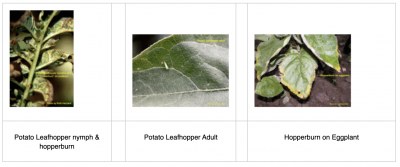Potato leafhopper (PLH) (link to photos in folder) is thought to be a native species. It overwinters on legumes in the Gulf states and disperses to northern states on wind currents annually. It usually arrives in Connecticut in June. Preferred hosts include alfalfa, beans, soybeans, potatoes, and to a lesser extent, eggplant, celery, cucumber, Jerusalem artichokes, squash, sweet potato, and rhubarb. Potato leafhopper adults are about 1/8 inch long, light-green and wedge-shaped, while nymphs are bright, almost neon-green.

Damage: Potato leafhoppers inject a toxin into the foliage while feeding which causes a symptom know as “hopperburn.” Leaf tips and margins first turn yellow or bronze, curl upward and then begin to die. Potatoes, beans and seedling eggplants can be killed outright by high numbers of PLH. Yields can be reduced in many years. On eggplant, symptoms of Verticillium wilt can resemble hopperburn, except that the edges of the leaves droop down instead of curling up. Drought can compound the damage.Life Cycle: Adult PLH arrive in June and can usually be found first in alfalfa or beans. They move to potatoes as the plants mature and contain more sugar. If high populations arrive, they may infest all hosts simultaneously. Adults may continue to migrate in from the south for a month or two. There are 5 nymphal instars and development from egg to adult takes 20-35 days. Females may lay up to 300 eggs. Generally, 2-3 generations occur each season in Connecticut during June and July. Prior to 1997, damaging populations only occurred in Connecticut every few years, but they have reached treatment thresholds every year since.
Monitoring and thresholds: Leafhoppers can be monitored by counting adults and nymphs on leaves or with a sweep net. Treat seedling beans if more than 2 adult leafhoppers are found per foot of row. Between the third trifoliate leaf and bud stage the bean threshold is 5 adult leafhoppers per foot of row. Adults move fast and will streak past you if you disturb the foliage while inspecting the plants. Treat eggplant if you find 1-1.5 adults or large nymphs per leaf. Treat potatoes if 5 adults or 15 large larvae are found on 50 leaves.
Management: Natural enemies include general predators such as lady beetles, lacewings, ants, spiders, and Nabid bugs, but they will not provide adequate control of leafhoppers. Provide adequate moisture through timely irrigation. Row covers can prevent leafhoppers from feeding on crops. To minimize spraying, choose insecticides with a long residual period of effectiveness such as systemic materials, if available. See the New England Vegetable Management Guide for a list of registered products on each crop.
By: T. Jude Boucher, University of Connecticut, Cooperative Extension System, January 2005. Reviewed 2012.
Information on our site was developed for conditions in the Northeast. Use in other geographical areas may be inappropriate.
The information in this document is for educational purposes only. The recommendations contained are based on the best available knowledge at the time of publication. Any reference to commercial products, trade or brand names is for information only, and no endorsement or approval is intended. The Cooperative Extension System does not guarantee or warrant the standard of any product referenced or imply approval of the product to the exclusion of others which also may be available. The University of Connecticut, Cooperative Extension System, College of Agriculture and Natural Resources is an equal opportunity program provider and employer.